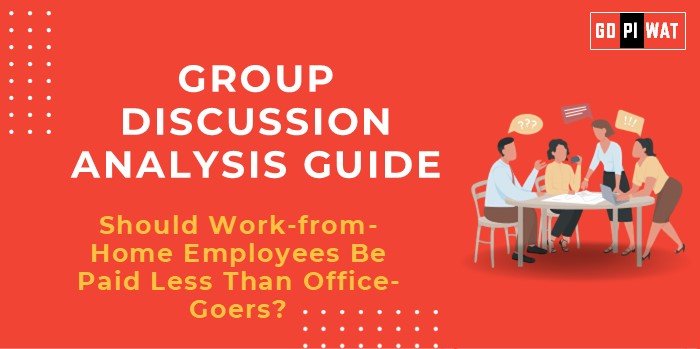📋 Group Discussion (GD) Analysis Guide: Should Work-from-Home Employees Be Paid Less Than Office-Goers?
🌐 Introduction to the Topic
- Opening Context: The global shift to remote work during and post-COVID-19 has redefined workplace norms, prompting debates about employee compensation. The question of whether work-from-home (WFH) employees should be paid less than office-goers is crucial for organizations balancing cost efficiency with fairness.
- Topic Background: The argument stems from perceived disparities in expenses incurred by office-goers, such as commuting and food, compared to the home-based cost savings for remote workers. However, critics argue this overlooks WFH costs like electricity and internet. Countries like the U.S., U.K., and India have seen diverse corporate responses, making it a significant topic for both employees and management.
📊 Quick Facts and Key Statistics
- 🏢 WFH Adoption: 74% of companies globally plan to maintain hybrid work models in 2024 (Gartner, 2023).
- 📈 Employee Productivity: 67% of remote workers reported equal or higher productivity compared to in-office work (Gallup, 2023).
- 💼 Employer Savings: Companies can save up to $11,000 annually per remote employee (Global Workplace Analytics, 2023).
- 📉 WFH Costs: Home-based workers reported a 12% rise in utility bills during remote work (Deloitte, 2023).
👥 Stakeholders and Their Roles
- 🏢 Employers: Decide on compensation strategies balancing equity and cost optimization.
- 👩💼 Employees: Advocate for fair pay regardless of location, considering productivity.
- 🏛️ Governments: Regulate labor policies to prevent exploitation in remote work arrangements.
- 🤝 Labor Unions: Protect worker rights amidst changing workplace dynamics.
🏆 Achievements and Challenges
✨ Achievements
- Cost Savings for Employers: Remote models reduce infrastructure and operational costs.
- Flexibility and Work-Life Balance: Employees enjoy reduced commuting time and personal autonomy.
- Expanded Talent Pool: Companies access skilled workers across geographies.
⚠️ Challenges
- Perceived Inequity: Pay differences could demotivate remote workers.
- Expense Misalignment: WFH entails hidden costs like electricity and high-speed internet.
- Cultural Divide: Lack of in-person interaction impacts team cohesion.
🌍 Global Comparisons
- U.S.: Some firms like Google adjusted pay based on geography, sparking debates on fairness.
- India: Most companies have retained uniform pay scales, prioritizing simplicity over cost-cutting.
📋 Case Studies
- Google: Reduced salaries for employees who moved to lower-cost cities under WFH policies.
- TCS India: Advocated a hybrid model with consistent compensation to retain morale.
💡 Structured Arguments for Discussion
- Supporting Stance: “WFH employees save on commuting, food, and relocation expenses, justifying slightly lower pay.”
- Opposing Stance: “Work-from-home workers often face higher utility costs and are equally productive, negating pay cuts.”
- Balanced Perspective: “While WFH may reduce some costs, pay should reflect role value and performance, not location.”
🔍 Effective Discussion Approaches
🌟 Opening Approaches
- Highlight cost-saving statistics for employers with WFH models.
- Introduce case studies like Google’s geo-based pay policy.
- Pose a question about balancing fairness and cost optimization.
💬 Counter-Argument Handling
- Emphasize equality of effort regardless of location.
- Compare WFH utility costs to commuting costs.
- Highlight long-term benefits of equitable pay for employee retention.
📈 Strategic Analysis of Strengths and Weaknesses
- Strengths: Enhanced flexibility, reduced overheads for companies.
- Weaknesses: Risk of perceived unfairness among employees.
- Opportunities: Retain talent with fair, performance-based pay.
- Threats: Risk of high attrition if workers feel undervalued.
📘 Connecting with B-School Applications
- Real-World Applications:
- Analyze cost-benefit strategies for WFH policies in HR and finance courses.
- Develop models for equitable pay policies in case competitions.
- Sample Interview Questions:
- “How should companies balance cost savings and equity in remote work compensation?”
- “What are the long-term impacts of WFH on employee productivity?”
- Insights for B-School Students:
- Understand evolving HR compensation trends.
- Evaluate WFH’s financial impact on organizational budgets.


